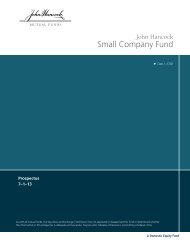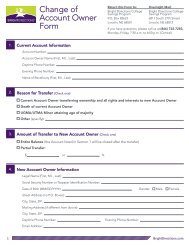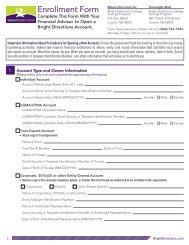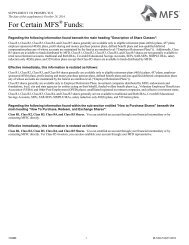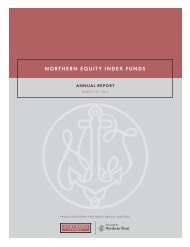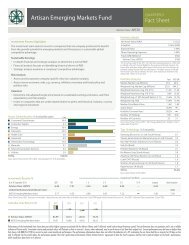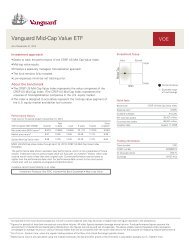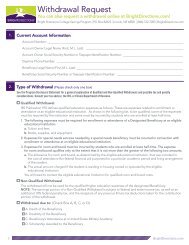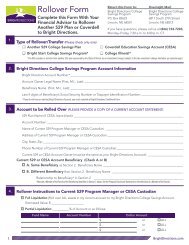Dodge & Cox Funds Statutoary Prospectus dated May 1, 2013
Dodge & Cox Funds Statutoary Prospectus dated May 1, 2013
Dodge & Cox Funds Statutoary Prospectus dated May 1, 2013
Create successful ePaper yourself
Turn your PDF publications into a flip-book with our unique Google optimized e-Paper software.
“junk” securities, have speculative characteristics. Thesesecurities may yield a higher level of current income thanhigher-rated securities, but generally have greater creditrisk, more price volatility, and less liquidity.▪ Call risk. During periods of falling interest rates, issuersof callable bonds may repay securities with higherinterest rates before maturity. This could cause theFund to lose potential price appreciation and reinvestthe proceeds at lower interest rates.▪ Liquidity risk. The Fund may not be able to purchase orsell a security in a timely manner or at desired prices orachieve its desired weighting in a security.▪ Nondiversification risk. As a non-diversified fund, theFund has the ability to invest a larger percentage of itsassets in securities of a smaller number of issuers than adiversified fund. As a result, the performance of a singleissuer could affect Fund performance more than if theFund were invested in a larger number of issuers.▪ Mortgage and asset-backed securities risk. Early repaymentof principal (e.g., prepayment of principal due to sale ofthe underlying property, refinancing, or foreclosure) ofmortgage-related or asset-backed securities (or othercallable securities) exposes the Fund to a potential losson any premium to face value paid and to a lower rateof return upon reinvestment of principal. Duringperiods of rising interest rates, prepayment rates maydecline below what was anticipated, delaying the returnof principal to the Fund and affecting its ability toreinvest at higher yields. In addition, changes in therate of prepayment also affect the price and pricevolatility of a mortgage-related or asset-backed security.Securities issued by certain U.S. government sponsoredenterprises (GSEs) (such as Fannie Mae, Freddie Mac,the Federal Home Loan Banks, and the Federal FarmCredit Banks) are not issued or guaranteed by the U.S.Treasury. In the event that these GSEs cannot meettheir obligations, there can be no assurance that theU.S. government will continue to provide support, andthe Fund’s performance could be adversely impacted.▪ Non-U.S. issuer risk. Securities may decline in valuebecause of political, economic, or market instability;the absence of accurate information about the issuers;risks of internal and external conflicts; or unfavorablegovernment actions, including expropriation andnationalization. These same factors may also cause adecline in the value of foreign currency, interest rate orcredit derivative instruments. Non-U.S. securities aresometimes less liquid, more volatile, and harder to valuethan securities of U.S. issuers. Lack of uniformaccounting, auditing, and financial reporting standards,with less governmental regulation and oversight thanU.S. companies, may increase risk. Some countries alsomay have different legal systems that may make itdifficult for the Fund to exercise creditor rights andpursue legal remedies with respect to investments.Certain of these risks may also apply to securities ofU.S. companies with significant non-U.S. operations.Furthermore, the issuer of non-U.S. sovereign debt orthe governmental authorities that control therepayment of debt may be unable or unwilling to repaythe principal or interest when due. This may result frompolitical or social factors, the general economicenvironment of a country or levels of foreign debt orforeign currency exchange rates.▪ Emerging market risk. Non-U.S. issuer risk may beparticularly high to the extent the Fund invests inemerging market securities. Emerging market securitiesmay present issuer, market, currency, liquidity, legal,political and other risks different from, and potentiallygreater than, the risks of investing in securities andinstruments tied to developed non-U.S. issuers.Emerging market securities may also be more volatile,less liquid and more difficult to value than securitieseconomically tied to developed non-U.S. issuers.▪ Non-U.S. currency risk. Non-U.S. currencies may declinerelative to the U.S. dollar and affect the Fund’sinvestments in non-U.S. currencies, in securities thattrade or receive revenues in non-U.S. currencies, or inderivatives that provide exposure to non-U.S. currencies.<strong>Dodge</strong> & <strong>Cox</strong> may not hedge or may not be successful inhedging the Fund’s currency exposure. The Fund alsobears transaction charges for currency exchange.▪ Derivatives risk. The Fund’s use of derivatives such ascurrency and interest rate derivatives and credit defaultswaps involves risks different from, and possibly greaterthan, the risks associated with investing directly insecurities and other more traditional investments.Derivatives are subject to potential changes in value inD ODGE & C OX F UNDS ▪ PAGE 23




